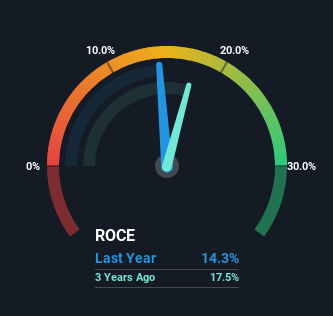Cool Caps Industries (NSE:COOLCAPS) Could Be Struggling To Allocate Capital
If we want to find a potential multi-bagger, often there are underlying trends that can provide clues. Ideally, a business will show two trends; firstly a growing return on capital employed (ROCE) and secondly, an increasing amount of capital employed. Put simply, these types of businesses are compounding machines, meaning they are continually reinvesting their earnings at ever-higher rates of return. In light of that, when we looked at Cool Caps Industries (NSE:COOLCAPS) and its ROCE trend, we weren't exactly thrilled.
Return On Capital Employed (ROCE): What Is It?
For those that aren't sure what ROCE is, it measures the amount of pre-tax profits a company can generate from the capital employed in its business. Analysts use this formula to calculate it for Cool Caps Industries:
Return on Capital Employed = Earnings Before Interest and Tax (EBIT) ÷ (Total Assets - Current Liabilities)
0.14 = ₹132m ÷ (₹1.6b - ₹674m) (Based on the trailing twelve months to September 2023).
So, Cool Caps Industries has an ROCE of 14%. That's a relatively normal return on capital, and it's around the 12% generated by the Packaging industry.
See our latest analysis for Cool Caps Industries

While the past is not representative of the future, it can be helpful to know how a company has performed historically, which is why we have this chart above. If you're interested in investigating Cool Caps Industries' past further, check out this free graph covering Cool Caps Industries' past earnings, revenue and cash flow.
So How Is Cool Caps Industries' ROCE Trending?
On the surface, the trend of ROCE at Cool Caps Industries doesn't inspire confidence. Over the last four years, returns on capital have decreased to 14% from 19% four years ago. However, given capital employed and revenue have both increased it appears that the business is currently pursuing growth, at the consequence of short term returns. And if the increased capital generates additional returns, the business, and thus shareholders, will benefit in the long run.
On a side note, Cool Caps Industries' current liabilities have increased over the last four years to 42% of total assets, effectively distorting the ROCE to some degree. Without this increase, it's likely that ROCE would be even lower than 14%. What this means is that in reality, a rather large portion of the business is being funded by the likes of the company's suppliers or short-term creditors, which can bring some risks of its own.
The Key Takeaway
In summary, despite lower returns in the short term, we're encouraged to see that Cool Caps Industries is reinvesting for growth and has higher sales as a result. However, despite the promising trends, the stock has fallen 36% over the last year, so there might be an opportunity here for astute investors. As a result, we'd recommend researching this stock further to uncover what other fundamentals of the business can show us.
On a final note, we found 5 warning signs for Cool Caps Industries (2 are significant) you should be aware of.
While Cool Caps Industries isn't earning the highest return, check out this free list of companies that are earning high returns on equity with solid balance sheets.
New: AI Stock Screener & Alerts
Our new AI Stock Screener scans the market every day to uncover opportunities.
• Dividend Powerhouses (3%+ Yield)
• Undervalued Small Caps with Insider Buying
• High growth Tech and AI Companies
Or build your own from over 50 metrics.
Have feedback on this article? Concerned about the content? Get in touch with us directly. Alternatively, email editorial-team (at) simplywallst.com.
This article by Simply Wall St is general in nature. We provide commentary based on historical data and analyst forecasts only using an unbiased methodology and our articles are not intended to be financial advice. It does not constitute a recommendation to buy or sell any stock, and does not take account of your objectives, or your financial situation. We aim to bring you long-term focused analysis driven by fundamental data. Note that our analysis may not factor in the latest price-sensitive company announcements or qualitative material. Simply Wall St has no position in any stocks mentioned.
About NSEI:COOLCAPS
Cool Caps Industries
Manufactures and sells a range of plastic caps, closures, and shrink and antimicrobial films to beverage industry in India.
Proven track record with imperfect balance sheet.
Similar Companies
Market Insights
Community Narratives


Recently Updated Narratives

Constellation Energy Dividends and Growth

CoreWeave's Revenue Expected to Rocket 77.88% in 5-Year Forecast

Bisalloy Steel Group will shine with a projected profit margin increase of 12.8%
Popular Narratives


MicroVision will explode future revenue by 380.37% with a vision towards success


NVDA: Expanding AI Demand Will Drive Major Data Center Investments Through 2026



